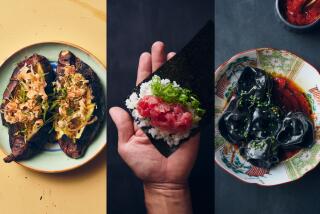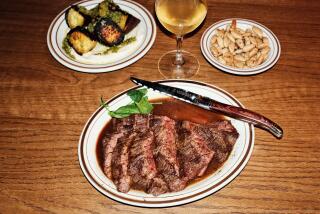A Mix of Cultures Lives Inside Yama Teppan House
- Share via
Picture a dining room with a Chinese manager, a blond hostess wearing a jet-black kimono and a team of chefs shouting epithets in Spanish and Japanese simultaneously. We are in the wonderful world of the teppan restaurant, a multicultural journey extraordinaire.
To complicate the matter further, Yama Teppan House sits in a quaint, Cape Cod-style structure in Dana Point. Purists never even make it through the door. And I spied one puzzled couple staring and staring at the menu mounted outside before they finally moved on to an Italian place nearby.
Had they gone inside, they would have found a tiny sushi bar where beach babes pour liquid amino acids into their teacups and the clientele is strictly California counterculture. And then there is the karaoke room, a cocktail bar where patrons can sing along to recorded accompaniment. I arrived just in time to catch a screeching rendition of “You’re So Sexy” followed by a more solemn reading of a song called “God Is Watching You.” That was just about the time our names were called, and the blonde in the kimono came to escort us to our seats in the teppan room.
Surely you’ve experienced Japanese teppan cooking, the art form popularized at Benihana of Tokyo, but here’s a brief refresher course anyway: You are seated with a group of strangers at a common table, the center of which is a flat metal grill.
After time for a silly drink crowned by a paper parasol, a chef in a white toque comes out and starts flipping food around on the grill, into the air, onto your plates. There is polite applause. He leaves. You leave.
Quirky though it may be, Yama Teppan House is a whole lot better than some of the places it imitates. The parent company of the restaurant is Yamamoto Yama, a Japanese company that is one of the world’s leading tea traders. The company hopes to make Yama a successful chain, and it has spent lavishly on this location.
The large teppan room is a stunner, cut down to size by several frosted glass dividers that limit the line of vision. The effect--reinforced by the robin’s-egg-blue grill hoods, black lacquer tables and noisy clatter of the chefs--is to make diners feel they are at a noisy private party.
One of Yama’s most interesting (and unexpected) pleasures is an oddball sushi list. Sushi is made up front but is available in the teppan room as well. Start with one of the imaginative hand rolls. There are a couple of real curiosities.
Caterpillar roll, for one: Looking disturbingly like its insect-world prototype, it is Osaka-style sushi (where the rice is topped, as opposed to stuffed, with the delicacy being showcased) made with avocado and crab, and it is artful and delicious, in the extreme.
Yama roll also is both unusual and wonderful: spicy yellowtail, enoki mushrooms and a saucy red marinade. No Japanese would claim it, but it’s hard to imagine one not enjoying it.
Teppan diners have the option of ordering appetizers from an ala carte menu. Pan-fried gyoza --Chinese dumplings with a pork, chive and ginger filling--are lighter and less oily than their counterparts in Chinese restaurants. Soft shell crab comes pan-fried, in a spicy orange sauce. Too bad the dish is such a small portion. It disappears with almost no resistance.
OK, it’s show time. While the chef prepares the grill, diners are brought lacquer bowls of a light miso (soybean paste) soup, a weak but refreshing sister of the miso you’d get in a less commercial restaurant.
The soup is followed by a rather ordinary salad of iceberg lettuce, but at least this restaurant spares you the bizarreness of topping it with Thousand Island dressing. I’d call this dressing Italian with some minced ginger added in.
The chef anoints the griddle with an ultra-light film of oil, lays down a carpet of pale yellow rice for frying and cracks whole eggs to scramble into the mix. The result is as palatable a fried rice as I’ve had in a teppan restaurant. Skimping on the oil, and the freshness of the rice, produces a home-cooked taste and the vegetables and egg make it tasty enough to eat without salt or soy.
The rest is easy. The chef cooks up a bland appetizer of diced shrimp, then the meat or fish of your choice. Filet mignon is like butter and the chefs are adept at preparing it to the degree of doneness you prefer. Fresh lobster, pricey at $23, is pulled right from the shell and flipped sizzling onto your stoneware dish.
The most flavorful seafoods probably are swordfish and scallops, but calamari, at $11, has to be the best value. The cheapest and least interesting entree is chicken. It’s served in tasteless chunks, coated with a sweet teriyaki sauce.
Entrees are followed by a pile of griddled vegetables, zucchini, onions, mushrooms and bean sprouts, and the last course is ice cream, a choice of green tea or sour plum.
The chefs here invariably leave their audiences to a round of applause, but it is the last thank you they really appreciate: Waitresses share their tips with chefs in this restaurant. Money, it would appear, transcends all cultures.
Yama is moderately priced. Steak, chicken and seafood dinners are $10.50 to $23.
*YAMA TEPPAN HOUSE * 24961 Dana Point Harbor Drive, Dana Point. * (714) 240-6610. * Lunch 11:30 a.m. through 2:30 p.m. Tuesdays through Sundays; 5 through 10 p.m. Sundays through Thursdays, Fridays and Saturdays till 11. * American Express, MasterCard and Visa accepted.
More to Read
Eat your way across L.A.
Get our weekly Tasting Notes newsletter for reviews, news and more.
You may occasionally receive promotional content from the Los Angeles Times.










